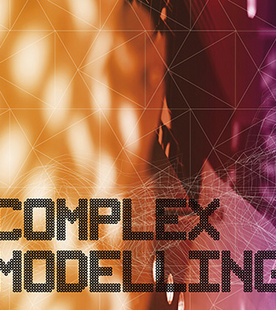Stressed Skin

Stressed Skins investigates the architectural and structural potentials of thin-skinned metallic structures. The structure was installed at the Danish Design Museum and is made of 186 unique planar pentagonal panels, arranged into an inner and outer skin. The project explores the modelling methods and digital fabrication work flows that enable very thin metal sheet to become strong through geometric and material manipulation. We develop modelling and robotic fabrication workflows to support the customised design and fabrication of a stressed skin structure.

Stressed skins are a structural hybrid, an intermediate between a monocoque and a rigid frame, utilising the capacity of a thin skin to transmit tensile, compressive and shear loads. This structural activation of the skin makes stressed skin structures strong and lightweight compared to conventional framed construction approaches.

This project finds inspiration in the pioneering research of Prouve’s folded sheet metal construction, LeRicolais’ structural elements and Junkers’ experimental metal housing. Stressed Skins places particular focus on predicting and incorporating material properties into design development. The project explores how an initially standardised and homogenous sheet of thin metal can gain strength and be made heterogeneous as a result of working and out-of-plane rigidisation. The geometry of rigidisation patterns is generated computationally and fabricated through a robotic process.



This allows us to form panels with locally customised geometries beyond those achievable by conventional rolling or stamping approaches. As the steel is formed, there is an increase in surface area and a corresponding local thinning of the material. From a forming perspective, it is important to calculate this change in geometric thickness so that the material does not tear or buckle as the thickness approaches zero. The process of forming also activates work hardening, with the effect of locally raising the yield strength of the steel. At an extreme, the yield strength can be almost doubled, while material thickness can decrease to zero. Stressed Skins examines how these small-scale operations have significant impact on large-scale behaviours.

To incorporate the implications of fabrication-based material transformation into the design process, Stressed Skins develops an inter-scale modelling approach with three defined scales: the structure, the panel and the material. An adaptive mesh-based approach is used to communicate information between these scales. We develop a method that adapts a non-structured grid to negotiate form-finding, analysis, fabrication and representation.





Publications
Nicholas, P., Schork, T. & Voorderhake, D. (2018) Full-scale Prototype of a Lightweight and Robotic Incrementally Formed Copper Facade System with Standing Seam Connections in Proceedings of the IASS Symposium 2018:Creativity in Structural Design. 8 p.
Nicholas, P., Zwierzycki, M., Clausen Nørgaard, E.,Leinweber, S., Stasiuk, D., Ramsgaard Thomsen,M. & Hutchinson, C. (2017) Adaptive Robotic Fabrication for Conditions of Material Inconsistency: Increasing the Geometric Accuracy of Incrementally Formed Metal Panels in A.
Menges, B. Shiel & M. Skavara (eds.) Fabricate 2017. UCL Press, p. 114-121 8 p.
Nicholas, P., Zwierzycki, M. & Ramsgaard Thomsen, M., (2017) Localised and Learnt Applications of Machine Learning for Robotic Incremental Sheet Forming in Proceedings of Design Modelling Symposium Paris 2017: Humanizing Digital Reality: Springer, p. 373-382 10 p.
Nicholas, P., Zwierzycki, M., Stasiuk, D., Nørgaard, E. C., Leinweber, S. & Ramsgaard Thomsen, M., (2016) Adaptive Meshing for Bi-directional Information Flows: A Multi-Scale Approach to Integrating Feedback between Design, Simulation, and Fabrication in Adriaenssens, S., Gramazio, F., Kohler, M., Menges, A. & Pauly, M. (eds.) Advances in Architectural Geometry 2016. 1 ed. Zürich: vdf Hochschulverlag AG an der ETH Zürich, p. 260-273 14 p.
Nicholas, P., Stasiuk, D., Nørgaard, E. C., Hutchinson, C. & Ramsgaard Thomsen, M., (2016) An Integrated Modelling and Toolpathing Approach for a Frameless Stressed Skin Structure, Fabricated Using Robotic Incremental Sheet Forming in Reinhardt, D., Saunders, R. & Burry, J. (eds.) Robotic Fabrication in Architecture,Art and Design. 1 ed. Cham: Springer, Vol. 2016. p.62-77 16 p.
Nicholas, P., Zwierzycki, M., Stasiuk, D. & Ramsgaard Thomsen, M. (2016) Concepts and Methodologies for Multi-scale Modelling: a Mesh-based Approach for Bi-directional Information Flows in Proceedings of the 36th Annual Conference of the Association for Computer Aided Design in Architecture (ACADIA): Posthuman Frontiers: Data, Designers, and Cognitive Machines. The Association for Computer-Aided Design in Architecture, p. 308-317 10 p.
Nicholas, P., Stasiuk, D., Nørgaard, E., Hutchinson, C. & Ramsgaard Thomsen, M. (2015) A Multiscale Adaptive Mesh Refinement Approach to Architectured Steel Specification in the Design of a Frameless Stressed Skin Structure in Proceedings of Design Modelling Symposium 2015:Modelling Behaviour: Ramsgaard Thomsen, M.,Tamke, M., Gengnagel, C., Faircloth, B. & Scheurer, F.(eds.). Cham: Springer, p. 17-34 17 p.
Machining and machine learning, Extending architectural digital fabrication through AI By Paul Nicholas, Book The Routledge Companion to Artificial Intelligence in Architecture Machining and machine learning | 25 | Extending architectural digital (taylorfrancis.com) https://www.taylorfrancis.com/chapters/edit/10.4324/9780367824259-25/machining-machine-learning-paul-nicholas





